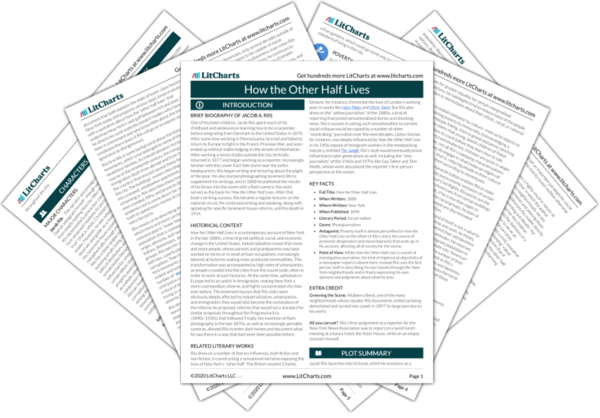Housing, Reform, and Improvement
Although the experiences and struggles of the urban poor that Riis documents are complex, for him they can ultimately be reduced to a single glaring issue: housing. In How the Other Half Lives, living conditions are isolated as the source of moral ills, of poverty and corruption, and of the alarming gap between rich and poor. But as a result, housing is also identified as the major means of counteracting poverty, becoming the centerpiece…
read analysis of Housing, Reform, and ImprovementPoverty and Morality
In nineteenth-century America (as in other times and places), one common explanation of poverty was that the poor were responsible for their own condition. Stereotyped as being lazy, impressionable, and prone to vice, their struggles were thought to be inevitable or even just retribution for their sins. Much of How the Other Half Lives is concerned with what Riis does consider moral failures, as he delves at length into alcoholism, prostitution, and parents’ abandonment of…
read analysis of Poverty and MoralityDiversity, Cosmopolitanism, and Ethnic Prejudice
One salient feature of the parts of New York that Riis examines is the diversity of ethnicities, languages, and traditions to be found in the poorest areas of the city. Already a journalist and photographer, Riis also puts on the hat of ethnographer, studying the specific and distinct cultural practices of many of these groups. But even as he argues for greater equality for certain marginalized populations, his typologies tend to reduce many of the…
read analysis of Diversity, Cosmopolitanism, and Ethnic Prejudice
Corruption
As he moves throughout the slums and tenements of the city, Riis draws on his experience as an investigative reporter in uncovering the relationship between money, power, and poverty in and beyond these areas. Indeed, in addition to simply recounting the sights he sees, Riis exposes the underlying connections between the shocking conditions of New York’s poor as well as the complex, subtle manipulations that often work to keep them in their place.
For instance…
read analysis of CorruptionPhotography and Visual Language
How the Other Half Lives is first and foremost a work of photojournalism—one of the first examples of this new genre, which combined narrative with photographic illustrations and which, in the twentieth century, would become a key tool for documenting and addressing inequality. A relatively new medium at the time, photography gave readers striking physical evidence of a world of which many were unaware or unwilling to believe existed. But even in addition to the…
read analysis of Photography and Visual LanguageThe Progressive Era and Immigration
How the Other Half Lives is an important example of—and in many ways helped to spark—the Progressive Era in American history, which is usually dated to the period between the 1890s and the 1920s. The Progressive Era was a period of diverse and wide-ranging social reforms prompted by sweeping changes in American life in the latter half of the nineteenth century, particularly industrialization, urbanization, and heightened rates of immigration. Rising levels of social and economic…
read analysis of The Progressive Era and Immigration






